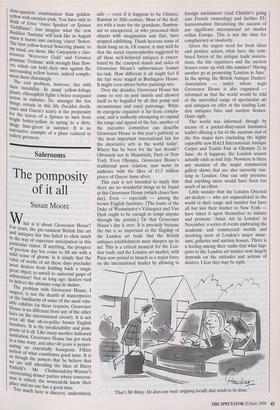Salerooms
The pomposity of it all
Susan Moore
What is it about Grosvenor House? For years, the pre-eminent British fine art and antiques fair has failed to elicit much in the way of expectant anticipation in this particular visitor. If anything, the prospect of preview day has come to fill me with a mild sense of gloom. Is it simply that the value of works of art these days precludes most dealers from holding back a single great object to unveil to universal gasps of admiration? Not so long ago, dealers vied to deliver the ultimate coup de theatre. The problem with Grosvenor House, I suspect, is not the dearth of masterpieces or the familiarity of some of the most valu- able exhibits (in these respects, Grosvenor House is no different from any of the other fairs on the international circuit). It is not even all that oh-so-polite brown English furniture. It is the predictability and pom- posity of it all. Like many another hallowed institution, Grosvenor House has got stuck in a time warp, and after 40 years is perpet- uating an essentially bourgeois, Fifties notion of what constitutes good taste. It is as though the powers that be believe that we are still attending the likes of Harry Enfield's Mr Cholmondeley-Warner's excruciating dinner parties where conversa- tion is stilted, the womenfolk know their place and no one has a good time. Too much here is discreet, understated, safe — even if it happens to be Chinese, Russian or 20th century. Most of the deal- ers with a taste for the grandiose, flamboy- ant or unexpected, or who presented their objects with imagination and flair, have stopped exhibiting. Thank heavens some of them hang on in. Of course, it may well be that the social claustrophobia suggested by all these well-behaved antiques is exacer- bated by the cramped stands and aisles of Grosvenor House's subterranean former ice-rink. How different it all might feel if the fair were staged at Burlington House. It might even attract better paintings too. Over the decades, Grosvenor House has come to rest on past laurels and allowed itself to be beguiled by all that pomp and circumstance and royal patronage. While its energetic organiser is far from compla- cent, and is endlessly attempting to expand the range and appeal of the fair, another of the executive committee can describe Grosvenor House in this year's publicity as `the most important international fair for the decorative arts in the world today'. Where has he been for the last decade? Obviously not in Maastricht, Paris or New York. Even Olympia, Grosvenor House's traditional poor relation, now wows its audience with the likes of £1.5 million pieces of Queen Anne silver. This rant is not intended to imply that there are no wonderful things to be found at this Grosvenor House (which closes Sun- day). Even — especially — among the brown English furniture. (The loans of the Duke of Westminster's Velazquez and Van Dyck ought to be enough to tempt anyone through the portals.) Or that Grosvenor House's day is over. It is precisely because the fair is so important as the flagship of the London art trade that the British antiques establishment must sharpen up its act. This is a critical moment for the Lon- don trade and the London art market, with Paris now poised to launch as a major force on the international market by allowing in foreign auctioneers (and Christie's going into French ownership) and further EU harmonisation threatening the success of any significant international art market within Europe. This is not the time for complacency or insularity. Given the urgent need for fresh ideas and positive action, what have the com- bined forces of the antique trade associa- tions, the fair organisers and the auction houses come up with this summer? Having another go at promoting 'London in June'. In the spring, the British Antique Dealers' Association — under whose aegis Grosvenor House is also organised - informed us that the world would be told of the unrivalled range of spectacular art and antiques on offer at the leading Lon- don antiques fairs and auction houses. Quite right.
The world was informed, though by means of a pocket-diary-sized laminated leaflet offering a list of the auctions and of the five major fairs (including the highly enjoyable new HALI International Antique Carpet and Textile Fair at Olympia 2) in June. As it happens, the London season actually ends in mid July. Nowhere is there any mention of the major commercial gallery shows that are also currently run- ning in London. One can only presume that anything more would have been too much of an effort.
Little wonder that the London Oriental art dealers — who are unparalleled in the world in their range and number but have all but lost their market to New York have taken it upon themselves to initiate and promote 'Asian Art in London' in November, a series of events embracing the academic and commercial worlds and involving most of London's major muse- ums, galleries and auction houses. There is a feeling among their ranks that what hap- pens to the London art market now largely depends on the attitudes and actions of dealers. I fear they may be right.
`That's Mr Briley. He does any male stripping locally that needs to be done.'


























































 Previous page
Previous page